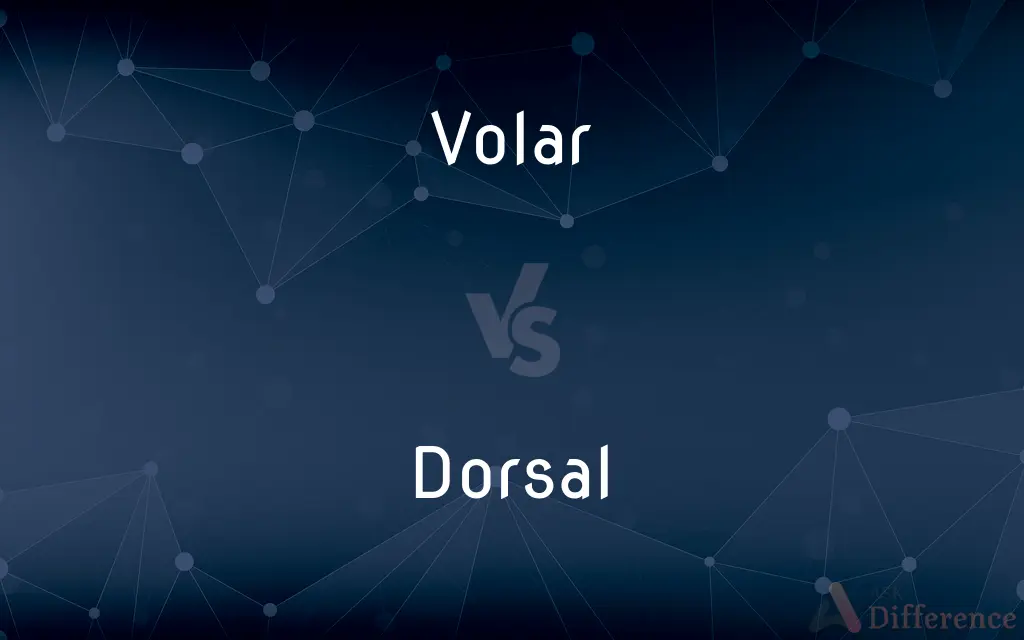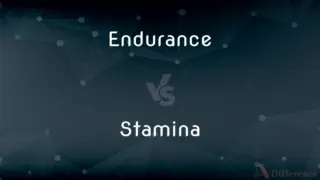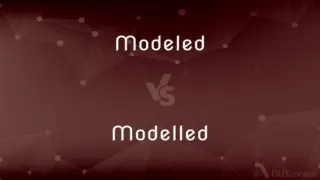Volar vs. Dorsal — What's the Difference?
By Tayyaba Rehman & Fiza Rafique — Updated on April 15, 2024
Volar refers to the palm side of the hand or the sole of the foot, emphasizing surfaces facing forward or downward; dorsal pertains to the back side of an organism, highlighting areas oriented away from the ground.

Difference Between Volar and Dorsal
Table of Contents
ADVERTISEMENT
Key Differences
Volar surfaces of the hand or foot face forward or downward, facilitating interaction and sensation, especially in touch and grip. Whereas, the dorsal surfaces relate to the back or outward-facing parts, such as the back of the hand or the top of the foot, often exposed to environmental elements more than volar areas.
The volar aspect is crucial in tasks requiring precision and tactile feedback, such as writing or manipulating tools. On the other hand, the dorsal aspect is less sensitive and more protective, suited for shielding against physical impacts and environmental hazards.
Volar regions often have a higher concentration of nerve endings and are more involved in sensory tasks. Conversely, dorsal regions typically have thicker skin and fewer nerve endings, prioritizing protection over sensation.
In medical and anatomical studies, understanding the volar and dorsal distinctions is vital for accurately describing injuries or surgical approaches. Whereas, in dorsal studies, emphasis is placed on aspects like alignment and external protection.
Volar treatments in healthcare, such as for carpal tunnel syndrome, focus on the sensitive, functional aspects of the palms or soles. On the other hand, dorsal treatments might address issues like skin conditions or muscular problems on the body’s posterior.
ADVERTISEMENT
Comparison Chart
Orientation
Faces forward or downward
Faces backward or upward
Sensitivity
High, with more nerve endings
Lower, with fewer nerve endings
Skin Characteristics
Thinner, more sensitive
Thicker, less sensitive
Function
Involved in grip and manipulation
Provides protection and support
Medical Relevance
Focus on sensitivity and dexterity
Focus on protection and alignment
Compare with Definitions
Volar
Pertaining to the palm of the hand or the sole of the foot.
The volar surface of her hand was soft and warm.
Dorsal
Pertaining to the back side of an organism.
The dorsal fin of the shark is its most recognizable feature.
Volar
Facing downward or forward.
He placed his volar side against the cool surface.
Dorsal
Related to the posterior in anatomical terms.
Dorsal muscles support the spine effectively.
Volar
Used in descriptions of approach or injury in anatomy.
Volar flexion is movement that bends the palm toward the wrist.
Dorsal
Involving the back side in medical contexts.
Dorsal splints are used to immobilize the wrist.
Volar
Related to the underside in anatomical position.
The surgeon focused on the volar side during the procedure.
Dorsal
Oriented away from the ground.
The dorsal surface of the leaf is less colorful than the underside.
Volar
Involving the palm or sole in medical contexts.
Volar pads are sensitive areas used for feeling textures.
Dorsal
Used in descriptions of protective or supportive roles.
The dorsal part of the boot is reinforced for extra support.
Volar
Of or relating to the sole of the foot or the palm of the hand.
Dorsal
(Anatomy) Of, toward, on, in, or near the back or upper surface of an organ, part, or organism.
Volar
(anatomy) Pertaining to the palm of the hand or the sole of the foot.
Dorsal
(Botany) Of or on the surface of an organ or part facing away from the axis; abaxial.
Volar
Of or pertaining to the palm of the hand or the sole of the foot.
Dorsal
With respect to, or concerning the side in which the backbone is located, or the analogous side of an invertebrate.
Volar
Relating to the palm of the hand or the sole of the foot;
The volar surface
The palmar muscle
Dorsal
(anatomy) Relating to the top surface of the foot or hand.
Dorsal
Produced using the dorsum of the tongue.
Dorsal
Having only one sharp side.
Dorsal
(botany) Relating to the surface naturally inferior, as of a leaf.
Dorsal
(botany) Relating to the surface naturally superior, as of a creeping hepatic moss.
Dorsal
(art) A hanging, usually of rich stuff, at the back of a throne, altar, etc.
Dorsal
Any of the longitudinal series of plates that encircle the body, excluding the ventral scales.
Dorsal
(linguistics) A sound produced using the dorsum of the tongue.
Dorsal
Pertaining to, or situated near, the back, or dorsum, of an animal or of one of its parts; notal; tergal; neural; as, the dorsal fin of a fish; the dorsal artery of the tongue; - opposed to ventral.
Dorsal
Pertaining to the surface naturally inferior, as of a leaf.
Dorsal
A hanging, usually of rich stuff, at the back of a throne, or of an altar, or in any similar position.
Dorsal
Belonging to or on or near the back or upper surface of an animal or organ or part;
The dorsal fin is the vertical fin on the back of a fish and certain marine mammals
Dorsal
Facing away from the axis of an organ or organism;
The abaxial surface of a leaf is the underside or side facing away from the stem
Common Curiosities
Why are volar areas more sensitive than dorsal areas?
Volar areas are more sensitive due to their role in tactile interactions and fine manipulations, requiring a dense distribution of sensory nerves.
What does volar mean in medical terms?
In medical terms, volar refers to the front or palm side of the hand or the bottom of the foot, areas that are typically more sensitive and intricate.
What is the dorsal position in anatomy?
The dorsal position in anatomy refers to the back or upper side of an organism, which is usually oriented away from the ground.
What kind of protective functions do dorsal surfaces serve?
Dorsal surfaces serve protective functions such as shielding against physical impacts and environmental hazards, thanks to their thicker skin and robust structure.
How does the treatment differ for conditions affecting volar versus dorsal areas?
Treatment for conditions affecting volar areas often focuses on restoring sensitivity and flexibility, while treatment for dorsal areas may emphasize protection and support, such as using braces or topical treatments.
What are examples of volar and dorsal in animals?
In animals, volar could refer to the underside of paws in quadrupeds, while dorsal might describe the top side of animals, such as the back of a dolphin or the shell of a turtle.
How do volar and dorsal aspects affect physical therapy?
In physical therapy, treatment plans focus on the volar aspects to improve fine motor skills and pain relief, whereas dorsal aspects may be targeted for strengthening and improving postural alignment.
Can volar and dorsal be used to describe body parts other than hands or feet?
Yes, volar and dorsal can describe orientations in other body parts, such as referring to the anterior and posterior sides of other limbs or anatomical structures.
How do footwear designs consider volar and dorsal aspects?
Footwear designs consider volar aspects for comfort and flexibility, particularly in the sole area, while dorsal considerations often involve support and protection for the top of the foot.
How do volar and dorsal surfaces differ in sensitivity?
Volar surfaces are more sensitive, featuring a higher concentration of nerve endings, whereas dorsal surfaces are tougher and designed more for protection.
What are common injuries associated with the volar surface?
Common injuries associated with the volar surface include burns, cuts, and carpal tunnel syndrome, all due to its exposed and sensitive nature.
Are there specific exercises that target volar or dorsal muscles?
Yes, specific exercises like grip strengthening target volar muscles, while exercises like back extensions focus on strengthening dorsal muscles.
What are the evolutionary advantages of distinct volar and dorsal surfaces?
The evolutionary advantages include enhanced tactile function and dexterity in volar surfaces for handling and sensation, while dorsal surfaces provide robust protection against predators and environmental elements.
How do volar and dorsal terms help in surgical procedures?
Volar and dorsal terms help surgeons describe and navigate anatomical positions accurately, ensuring precise approaches to surgery and treatment.
Why is it important to distinguish between volar and dorsal in clinical assessments?
Distinguishing between volar and dorsal in clinical assessments is crucial for accurate diagnosis and treatment planning, especially in cases of injuries or abnormalities, ensuring the correct approach to each specific area.
Share Your Discovery

Previous Comparison
Endurance vs. Stamina
Next Comparison
Modeled vs. ModelledAuthor Spotlight
Written by
Tayyaba RehmanTayyaba Rehman is a distinguished writer, currently serving as a primary contributor to askdifference.com. As a researcher in semantics and etymology, Tayyaba's passion for the complexity of languages and their distinctions has found a perfect home on the platform. Tayyaba delves into the intricacies of language, distinguishing between commonly confused words and phrases, thereby providing clarity for readers worldwide.
Co-written by
Fiza RafiqueFiza Rafique is a skilled content writer at AskDifference.com, where she meticulously refines and enhances written pieces. Drawing from her vast editorial expertise, Fiza ensures clarity, accuracy, and precision in every article. Passionate about language, she continually seeks to elevate the quality of content for readers worldwide.














































